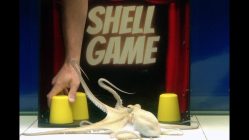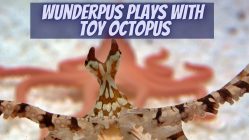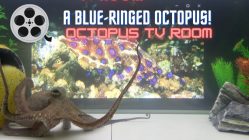The wondrous world of the octopus is filled with amazement on so many levels. Their brain power, their range of sizes, their colors, personalities — spending any amount of time studying or observing octopuses is going to make you respect and admire these creatures to a level you wouldn’t have thought possible.
To get a fuller range of knowledge about the octopus it is beneficial if you familiarize yourself with their taxonomy. This will allow you to understand the difference between the 300 species of octopus that inhabit the oceans. It will make it possible for you to understand why different species live in different regions. It will allow you to detect many traits that all octopuses share in common while also being keenly aware of the unique differences that each species possesses. Essentially, it gives you the keys to the vehicle that will power you on your own path of self-learning about our eight-armed friends.
Don’t worry, to be a knowledgeable octopus enthusiast a degree in marine biology is not required. All that you need is some basic background information about how octopuses are classified and that will open up the doors to the octopus universe. You will find that even a tiny dose of structured knowledge about their classification will allow you to derive more benefit from your own collateral reading on octopuses than years of intense coursework. Observing octopuses in an aquarium or through underwater video footage will be more satisfying because you will now have a base context which you can use to organize all of the information that you will derive from your observations.
— The Basics of the Scientific Classification Method —
As an octopus enthusiast, you are not expected to be versed in the proper terminology that is used in the classification of living creatures right off the bat. Some of you may remember some of this stuff from jr. high or high school biology, as such, it may come rushing back to you. However, if it doesn’t, you’ll still do fine. Think of this basic classification system as any other type of classification system. For example, that of a video site, such as Netflix.
Netflix is the main site. Its library consists of TV show episodes and movies. This is the first sub-division in their classification system for the content that they offer you. Each of these branches can be further sub-divided into more detailed categories such as comedies, dramas, action flicks, etc. These can then be sub-divided further by their date of original release, starring actors, etc. Life forms, such as the octopus, us humans, and even that houseplant that you forgot to water, are classified using a similar methodology.
By using this type of classification system you can see how creatures are related to each other on an evolutionary scale. Pretty cool stuff if you ask us. Sort of like the family tree of all family trees.
— Time to Classify That Octopus —
Okay, now that the scientific classification system has been demystified, let’s see where the 300+ species of octopuses fit into this scheme of things.
Starting from the very top, an octopus belongs to the Animalia Kingdom. As most of you should easily deduce by that, this means that an octopus is an animal, not a plant. If any of you thought that an octopus was a plant prior to this — shame on you!
The next main classification division for the octopus comes in identifying its Phylum. This would be Mollusca. Let that sink in for a second. What do you think that indicates? That’s right, an octopus is a mollusk. In other words, the octopus belongs to the same overarching group that includes clams and mussels in the oceans and slugs and snails on land. Yes, that garden snail that you accidentally stepped on in your backyard is a very distant cousin of the octopus.
Up next in the classification system is the “Class” of the octopus. No, octopuses are not oceanic “elitists.” Class merely refers to the third tier of classification. This would be Cephalopoda. This is why in your reading about the octopus you will frequently encounter references to them being “cephalopods.”
When you get down to this tier of classification the octopus is in the company of squids and cuttlefish. The differences are still ample but no longer as vast as in the top two tiers.
— The Nitty-Gritty in Octopus Classification —
We now come to the meat of octopus classification — the “Order.” This would be the Order Octopoda — which means “eight feet.” Before you all start screaming that an octopus has eight “arms” not “feet,” you are correct. You must bear in mind that this term was selected in 1818. Besides, it is from “Octopoda” that the more common word, “octopus,” was derived from and is still in use today.
Every animal belonging to the Order of Octopoda is officially an octopus. However, the sub-divisions don’t end there. Don’t worry, we only have one more classification tier to concern ourselves with — the “sub-order.”
As you might have guessed, the sub-order is a segmentation of the order. Octopoda is divided into two sub-orders, Incirrina and Cirrina.
— Sub-Order Incirrina —
The Incirrina sub-order, also known as Incirrata, is the lineage to which the species of octopuses that you would be most familiar with happen to belong.
These types of octopus have the classical bulbous octopus head and do not have any fins. If you’re scratching your head about octopuses with fins, we will cover that subject further into the article.
Incirrina octopi have smooth suckers and lack any sort of internal supporting structure.
Incirrina octopi tend to live in shallower water. This makes it easier for us mere humans to observe them directly in their natural habitat. It also makes these types of octopuses easier to keep in controlled habitats.
Before you start thinking that the Incirrina sub-order as being boring and generic, take note that the argonaut octopuses also belong to this sub-order. There will be more on them down below.
— Sub-Order Cirrina —
The Cirrina sub-order is home to some of the most interesting looking octopuses.
First, the species belonging to this sub-order have suckers which possess cirri.
Cirri are small filaments — strands if you will — that are usually found in pairs on each of the suckers of these types of octopus. The cirri are not present to make some sort of fashion statement, although in species such as the “blind octopus” (Cirrothauma murrayi) they can be quite prominent. It is thought that they are used to generate small currents in the water near the octopus to attract prey.
Cirrina species have fins attached to their heads. This is perhaps best represented in the adorable dumbo octopus species. The fins are used for propulsion and directional control when the octopus is moving through the water.
The fact that the Cirrina sub-order have fins is only possible thanks to another evolutionary trait unique to that sub-order. This is the presence of an internal shell composed of a cartilage-like substance. This provides the added support needed in the head for the fins to be attached and controlled by strong muscle tissue.
Cirina species tend to have some variant of webbing connecting their arms. If you have ever heard of the generic term “blanket octopus,” these types of octopus belong to the Cirrina sub-order.
Most of the octopus species which live in the deepest depths of the ocean are from the Cirrina sub-order.
— The Short of Octopus Classification —
The simplest way to make sense of the 300+ species of octopus is by seeing them along the lines of the two sub-orders, Incirrina and Cirrina.
Remember that the first group is home to octopuses that fit the overall evolutionary design that we are familiar with when we think of octopi since we were kids. You know, the soft squishy body, large head, and smooth suckers.
The Cirrina group is home to the more “exotic” octopuses. They will have fins, an internal soft shell, filaments on their suckers, and webbing between their arms.
By being aware of just that basic distinction you will be miles ahead of most people. The next time you are at an aquarium or watching a marine life documentary with friends, you will be able to impress them with your knowledge of octopus types.
— Specific Types of Octopus —
To get a fuller appreciation for the diversity of octopods, here are some of the unique types that inhabit our oceans.
— Argonauts —
Maybe you recall reading about argonauts in the classic “Twenty Thousand Leagues Under the Sea” by Jules Verne. Maybe you saw them in a documentary about exotic marine life. Then again, maybe you’ve never heard of them. If you fall into the latter camp, don’t worry. We’d be willing to wager that the majority of people reading this article can share that claim.
An argonaut is a unique type of octopus. They are sometimes referred to as the “paper nautilus.” What makes them so special is that at first sight, they seem to possess a shell very similar to another cephalopod, the nautilus. The difference with the argonaut is that it does not live in its shell and only females have their version of a “shell.”
What superficially looks like a shell is, in fact, a protective egg case. It is very thin and easy to damage, hence the “paper nautilus” reference. When this type of octopus was first discovered, it was thought that they borrowed shells from other sea creatures and used them as improvised egg sacs. It was later learned through direct observation that argonauts do grow their own shell. The primary component of the shell is calcite.
Argonauts live in tropical and sub-tropical waters in the open sea. Females tend to be five to ten times larger than males of their species.
— Octopus Vulgaris —
The octopus vulagaris species is also known as the “common octopus.” It is the species which has been studied the most. While it may be difficult for an octopus enthusiast to think about, this species of octopus is also one of the most popular for human consumption.
It can be found throughout the Mediterranean, Eastern Atlantic Ocean, the Northwestern coast of Africa, the Western Atlantic, and the Western Pacific Ocean. Definitely one of the most cosmopolitan of all octopi.
Many of the observational experiments that have been conducted to determine octopus intelligence and cognition have used the common octopus as the main subject.
— The Blind Octopus —
We made mention of the blind octopus when we were introducing you to the Cirrina sub-order of octopods. The formal name of this species is Cirrothauma murrayi. It was named after the man who was leading the expedition which caught the first specimen of this species, Sir John Murray.
When you think of an octopus you normally think of a creature with prominent eyes. When you look into the eyes of most octopi they seem to express feeling and mood, some people might even say, emotion. Studies have indicated that most species of octopus have a highly-developed sense of vision complete with complex eye structures. Even though most octopuses are believed to be color-blind, their vision is keenly acute. This is why the blind octopus stands out from other species.
The blind octopus has very small eyes. They appear as tiny dots made with a permanent marker on its head. The lack of prominence of the eyes is because they lack ciliary bodies, lenses, and irises. In other words, their eyes lack everything that makes eyes functional. Their eyes can only detect the presence of light but cannot make out shapes. By any measure, the blind octopus is in fact truly blind. It is theorized that this lack of practical functionality is what has resulted in the eyes of the blind octopus to be buried deep within the tissue of their head making them appear as small dots.
Before you start organizing a Go Fund Me page for the blind octopus be aware that this species lives at depths ranging from 5,000 to nearly 15,000 feet. At those depths, very little light is able to penetrate so they don’t really need finely tuned vision. It is able to hunt fish and crustaceans without any difficulty.
The rest of the blind octopus’ body adheres to the Cirrina mold. It has two large fins on the side of its head and it has webbing between its arms. When the arms are spread it can “hover” in a “Medussa-like” pose.
It is found throughout the world’s oceans and can reach lengths of up to 15 feet.
— Atlantic Pigmy Octopus —
In contrast to the large, sightless, deep-water loving blind octopus, there is the Atlantic Pigmy Octopus.
This little fellow prefers shallow waters in warm regions, such as off the coast of the Cayman Islands and other parts of the Caribbean. Adults usually weigh no more than one ounce and rarely reach a length that surpasses six inches.
A member of the Incirrata sub-order, its body shape and proportion of the length of its arms to its head is similar to that of the common octopus, only smaller.
— Venomous Octopuses —
When the topic of venomous octopuses is brought up it takes many people by surprise. Not many folks know that an octopus can be venomous.
If you ask a person who is knowledgeable about octopuses they will always bring up the blue-ringed octopus as the quintessential example of a venomous octopus. This is done with good reason. This small octopus carries a dose of venom that could kill up to 26 adult humans. You have to admit that is one deadly octopod. It is even more impressive when you realize that they rarely grow beyond ten inches in length.
The toxicity of the blue-ringed octopus may seem out of place. After all, why pack such a lethal dose?
It uses its venom to paralyze prey in order to facilitate its consumption. Blue-ringed octopuses eat small crustaceans and the occasional injured small fish. The reason to immobilize its prey before eating it is that they wouldn’t want a creature with claws and sharp bits moving around inside of them before the digestive process kills them. Let’s be honest, neither would you.
This is why all venomous octopuses first inject their prey with venom prior to ingesting them. They do this by using their beak found at the tip of their mouth to penetrate their victim and pass along the deadly toxin. Some octopuses are also able to secrete toxin along their arms, especially on the tips. When they release their toxin in this way it is usually as a defensive maneuver. If a predator were to try to capture the octopus they would receive a dose of the toxin and be paralyzed giving the octopus time to flee.
It was once believed that only a few species of octopus had this ability to transmit toxins. The reality, however, is that all of the 300 species of octopus are venomous. For us humans, the reason that we place so much attention on the toxicity of the blue-ringed octopus is that it is the only species of octopus that is venomous to a human being. However, for the other sea creatures, especially those that are the preferred prey for octopuses, their venom is lethal.
In the animal world — in the plant world as well for that matter — life forms that are poisonous usually make their own toxin within their bodies using specialized parts of their endocrine systems. A classic example of this on land would be how snakes make their venom. They rely on glands located in their mouths very similar to salivatory glands.
Octopuses do not follow this model. Instead, as is the case with the blue-ringed octopus, the primary component of their deadly toxin is a substance called tetrodotoxin. Mind you, they are not the only animals to use that tetrodotoxin in this manner. Some starfish, crabs, frogs, and puffer fish also use this as the main ingredient for their poison.
Similar to those animals, the octopus relies on specialized bacteria to create deadly doses of the toxin within their own bodies. In other words, the immune system of the octopus knows not to attack that specific type of bacteria. It is a symbiotic relationship between the bacteria and the octopus. The bacteria get a safe place to live within the octopus and the octopus gets the benefit of having a poison factory working within it.
Leave it to octopus to “outsource” the production of poison.
— The Mimic Octopus —
The mimic octopus has a unique place among octopus species. It was only recently discovered in 1998.
At first glance, the mimic octopus resembles what you would expect from any Incirrina type of octopus. About the only distinguishing characteristics that you would notice immediately are that its arms are somewhat longer in proportion to its head than other Incirrina octopuses and the presence of a brown and white striped color pattern on its skin.
However, that description of the mimic octopus is when it is at rest in a benign state. Under normal circumstances, you would not so easily be able to see, much less, identify the mimic octopus. This is because of its incredible ability to mimic other life-forms. This may also explain why even though it lives in relatively shallow water near coastal regions it was one the most recent octopus species to be discovered. The harder something is to be seen, the more difficult it is to be discovered. Ask any aspiring young actor or actress and they will surely tell you the same thing.
Many species of octopus, especially in the Incirrina suborder, have the ability to change color to match their surroundings. As such, the art of chameleon-like camouflaging capabilities is not necessarily such a special thing among octopi. For some species, the level of detail in the color change is so precise and detailed that from even short distances it can seem like the octopus just disappeared. Their changes, however impressive as they may seem, are limited to color changes brought about by capillary type tissue on their skin.
The mimic octopus not only possesses this same ability to change color, but it also coordinates it with precise muscular manipulation of their arms and skin tissue so that they can literally take the shape and form of other sea creatures.
Not only are they able to pull this type of mimicry off while being stationary, but they can also emulate the movement of the creatures that they are mimicking. This allows them to use this type of natural deception not only to scare off potential predators but also to attract and catch prey.
At the moment, it is the only species that is known to have this type of ability. Then again, it would not be surprising for other similar species to exist since spotting one would not be an easy task.
— Pacific Giant Octopus and Other Large Species —
Not so long ago, the image of the octopus — especially that portrayed in literature and movies — was that of a gigantic creature capable of grabbing and strangling sailors or reaching out of the water and dragging entire ships to the depths with their arms. This used to give people the mistaken notion that octopuses were generally large creatures.
Even if you are someone who is just beginning on their journey as an octopus enthusiast, you’re already aware that most octopus species are rather small. Most can be measured in lengths of inches or just a few feet.
This is why the Pacific giant octopus has an important role in the diversity of octopi in general. You see, this species of octopus holds the title of being the largest. The longest specimen ever caught measured just over 15 feet in length.
While 15 feet is definitely big, it by no means is as large as some of those sci-fi movies from yesteryear made octopuses out to be. Of course, just because the largest specimen caught measured 15 feet does not mean that that is as large as the Pacific giant octopus can get. As a matter of fact, many marine biologists speculate that it can grow much larger — perhaps reaching sizes of 25 to 30 feet.
The Pacific giant octopus lives in the Pacific ocean and prefers water depths of approximately 200 feet. It can dive deeper in order to catch prey or if it feels that it is in danger. Being an Incirrina type of octopus, it is able to change color when needed.
As a large as it is, when the Pacific giant octopus drapes itself on the ocean floor with its arms spread out and its skin color matching that of the substrate, it does an excellent job at camouflaging itself. Yes, even the largest of octopi can just blend in.
The only other octopus species which can rival the Pacific giant octopus in size is what is commonly known as the “seven-arm octopus.” Formally it is the Haliphron atlanticus.
First, allow us to clarify that the term seven-arm octopus is a bit of a misnomer. All octopuses have eight arms, including the seven-arm octopus. The reason that this species got this particular common name is that males of the species appear to have only seven arms. This is because one of their arms is much shorter than the other seven and it is kept coiled up in a pouch-like sac beneath the animal’s right eye. The reason for this is because it is used when it is mating with a female in order to deliver sperm to the eggs. Yes, some octopi can be a little bit freaky.
The largest specimen of the seven-arm octopus which has been caught measured 13 feet. Again, much like the Pacific giant octopus, it is likely that larger specimens exist which have not been caught.
A curious side note about the seven-arm octopus is the relationship that it maintains with certain species of jellyfish. Observational studies have demonstrated repeated instances of seven-arm octopuses “paling” around with jellyfish.
It is unclear as to the nature of their relationship. It is not a case of the octopus hunting the jellyfish for food. They have never been observed eating them. It is not a case of the jellyfish feeding off parasites on the seven-arm octopus’s body. Nor is it a case of the jellyfish scavenging for scraps of what the octopus eats.
Some observers speculate that the octopus interacts with the jellyfish and keeps it close as a means of protection. This would be similar to a human keeping a watchdog. Many sea creatures avoid jellyfish to avoid their sting. It would seem as if the seven-arm octopus has “weaponized” or “domesticated” jellyfish to its advantage.
As you can see, the more that each species of octopus is observed, the more facts that come out about their complex and interesting behavior.
— Octopus Takeaways —
With over 300 species of octopuses in the world, even the most dedicated of octopus enthusiasts would be hard-pressed to memorize every single one.
This is why one of the biggest takeaways from this article is how to simplify the identification process of octopuses by always thinking about the division of the two suborders, Cirrina and Incirrina. That will make life a whole lot easier for you when you spot an octopus and it will also help you to explain to others the main differences between octopuses. It is like knowing the difference between sugar and salt on the dinner table. While they may look similar, they have fundamental differences.
In short, by being aware of the primary characteristics of the Incirrina octopuses and those of the Cirrina octopuses, you will be in a much better position to engage other people who are more knowledgeable about the octopus — even marine biologists — and be able to sustain an intelligent and constructive conversation


























